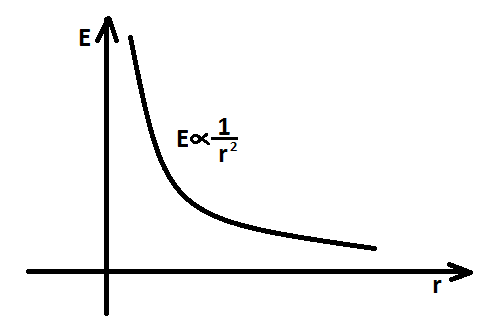
The intensity of electric field E due to charge Q at distance r.
A.$E \propto r$
B.$E \propto \dfrac{1}{{{r^2}}}$
C.$E \propto \dfrac{1}{r}$
D.$E \propto \dfrac{1}{{{r^3}}}$
Answer
470.7k+ views
Hint: In this question we use electric potential i.e. at a point is defined as the amount of work done in bringing a unit positive charge from infinity to that point. Unit of potential is $1V = 1\dfrac{J}{C}$,
$V\dfrac{W}{Q}$ , and we will also use Coulomb’s Law.
Formula used: $E = k\dfrac{Q}{{{r^2}}}$
Complete answer:
The power of the electric field is the force unit charge. It is the intensity at a particular point where it applies force on the charge when we put a charge.
For example, if E is the electrical field created at point P by a charge Q located at r distance from charge Q, let's now place a charge q at point P. Then, we observe force experienced by charge $F = qE$
Hence, from Coulomb’s Law:
$E = k\dfrac{Q}{{{r^2}}}$
Where E is an electric field, q is charged at a distance r and k is a constant. Therefore,
$E \propto \dfrac{1}{{{r^2}}}$
The graph between the electric field and the distance r will be parabolic which is shown below,

Hence option (B) is the correct answer.
Additional information:
The electric field and the electrostatic force can be related with a formula which states that the electric field due to a unit electric positive charge at a given point is equal to the electrostatic force divided by the charge, this can be written mathematically as follows,
$E = \dfrac{F}{q}$, where $E = $electric field, $F = $electrostatic force, $q = $charge.
The electric field intensity at a point is the force experienced by a unit charge placed at that point, and Electric field intensity is a vector quantity.
Note:
In this question we have used the Coulomb’s Law: So, it states that the magnitude of the electrostatic force of attraction or repulsion between two-point loads is directly proportional to the sum of the magnitudes of loads and inversely proportional to the square of the distance between them. The Force joins them along the straight line. The electrostatic force between them is repulsive if the two charges have the same sign; if they have different signs, the force between them is attractive.
$V\dfrac{W}{Q}$ , and we will also use Coulomb’s Law.
Formula used: $E = k\dfrac{Q}{{{r^2}}}$
Complete answer:
The power of the electric field is the force unit charge. It is the intensity at a particular point where it applies force on the charge when we put a charge.
For example, if E is the electrical field created at point P by a charge Q located at r distance from charge Q, let's now place a charge q at point P. Then, we observe force experienced by charge $F = qE$
Hence, from Coulomb’s Law:
$E = k\dfrac{Q}{{{r^2}}}$
Where E is an electric field, q is charged at a distance r and k is a constant. Therefore,
$E \propto \dfrac{1}{{{r^2}}}$
The graph between the electric field and the distance r will be parabolic which is shown below,

Hence option (B) is the correct answer.
Additional information:
The electric field and the electrostatic force can be related with a formula which states that the electric field due to a unit electric positive charge at a given point is equal to the electrostatic force divided by the charge, this can be written mathematically as follows,
$E = \dfrac{F}{q}$, where $E = $electric field, $F = $electrostatic force, $q = $charge.
The electric field intensity at a point is the force experienced by a unit charge placed at that point, and Electric field intensity is a vector quantity.
Note:
In this question we have used the Coulomb’s Law: So, it states that the magnitude of the electrostatic force of attraction or repulsion between two-point loads is directly proportional to the sum of the magnitudes of loads and inversely proportional to the square of the distance between them. The Force joins them along the straight line. The electrostatic force between them is repulsive if the two charges have the same sign; if they have different signs, the force between them is attractive.
Recently Updated Pages
The correct geometry and hybridization for XeF4 are class 11 chemistry CBSE

Water softening by Clarks process uses ACalcium bicarbonate class 11 chemistry CBSE

With reference to graphite and diamond which of the class 11 chemistry CBSE

A certain household has consumed 250 units of energy class 11 physics CBSE

The lightest metal known is A beryllium B lithium C class 11 chemistry CBSE

What is the formula mass of the iodine molecule class 11 chemistry CBSE

Trending doubts
Is Cellular respiration an Oxidation or Reduction class 11 chemistry CBSE

In electron dot structure the valence shell electrons class 11 chemistry CBSE

What is the Pitti Island famous for ABird Sanctuary class 11 social science CBSE

State the laws of reflection of light

One Metric ton is equal to kg A 10000 B 1000 C 100 class 11 physics CBSE

Difference Between Prokaryotic Cells and Eukaryotic Cells




